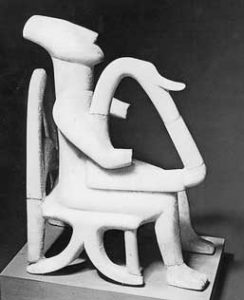History of the Cycladic Civilization

Human presence is witnessed in the Cyclades as early as the 9th millennium BC. and it is connected with the numerous indications we have of obsidian mining of excellent quality from Milos. The hard volcanic material was one of the most sought-after raw materials for the manufacture of tools and weapons throughout the Aegean during the Neolithic era and did not stop being used until the end of the Bronze Age (12th century BC).
Permanent settlement of inhabitants on the islands, however, is confirmed only during the Late Neolithic Period (c. 5000 BC) in Andros, Naxos, Antiparos, Amorgos, Santorini and elsewhere. The earliest settlements were small communities that relied almost exclusively on agriculture, animal husbandry and fishing for their survival.

Essentially, the islands of the Cyclades form a kind of natural bridge between Europe and Asia, mainland Greece and Crete. In the 3rd millennium BC, the ships of the Cycladic islands dominate the Aegean and together with the products of the Near East, they carry ideas, technical knowledge, religious concepts to Europe.
In almost all the islands of the Cyclades, the archaeological dig brought to light settlements, not extensive ones, of the 3rd millennium BC. Each settlement seems to have developed autonomously and there was no central authority of any kind. Initially the settlements are formed near the sea or on the slopes of low hills.

In the 2nd millennium BC the Cyclades have contacts with mainland Greece first and then with Crete. Settlements grow, buildings are more complex and imposing. The most important settlement of this era is Akrotiri in Thira.
Around 1600 BC, when large Cycladic settlements were destroyed by an earthquake, the Cyclades passed into the sphere of influence of Minoan Crete, which experienced its greatest prosperity at the time.
After the destruction of the Minoan palaces, around 1450 BC, the Cyclades were dominated by the Mycenaeans from mainland Greece, who transmitted to the islands the characteristics of their own culture in technology, art and religion.
The most characteristic creation of Cycladic art during the Bronze Age is the marble figurines. Most depict naked women, a few male musicians, warriors or hunters. The figures are strongly stylized, with few but distinctive details to identify gender.
The clay vessels, which have a variety of shapes, are decorated with simple linear designs. Particularly impressive are the marble vases, as well as the metal ones with simple engraved decoration.
History
Based on the archaeological findings, the colonization of the Aegean islands did not occur simultaneously. Their distance from the nearest land, size, geomorphology, climate and available wealth-producing sources are factors that attract or prevent the habitation of islands. According to archaeological findings from Milos, the human presence on the Aegean island dates back to the Upper Paleolithic and is linked to the mining of obsidian for the manufacture of sharp tools.

Obsidian, a black volcanic rock with a glassy texture, has a limited number of sources of origin in the Greek area (Milos, Antiparos and Giali Nisyrou). This material was used, due to its composition and durability, already at the end of the Upper Paleolithic (9th millennium BC. AD), for the manufacture of blades with sharp edges, which were used as knives, scrapers and razors.

The finding of obsidian tools from Milos in Mesolithic settlement layers in the Fraghthi cave of Hermionida attests to navigation in the Aegean as early as the 9th millennium BC The mining and trading of obsidian was carried out, from the end of the Paleolithic and during most of the Neolithic era (around 6800-3200 BC), not by groups permanently settled in the area of the Milos quarries, but by specialized groups, which they arrived on the island from settlements of the central and southern Aegean.
According to the prevailing view, based on the study of obsidian artefacts (cores, flakes and tools) from archaeological sites in central and southern Greece, mining was followed by on-site pre-processing of the raw material, at least during the Early and Middle Neolithic (ca. 6800- 5300 BC). During the Late and Late Neolithic (around 5300-3200 BC), when the systematic settlement of the Cyclades became denser, the traffic of obsidian diversified and joined the increasingly complex commercial networks of the Aegean. The obsidian then reached the settlements beyond the Cyclades in the form of roughly worked cores.
Early Cycladic (civilization 3000-2000 BC)

In the Cyclades, small, coastal settlements were established during the Proto-Cycladic I and II, while there are also small settlements inside the larger islands. During the transition phase, after 2300 BC, settlements are located on steep, coastal hills or on high ground, remote from the coast. Several of them are fortified, a fact linked to possible population movements from the northern Aegean islands to the Cyclades.
Sarkos in Ios island is the largest and best preserved settlement of the Proto-Cycladic II period (2700-2400/2300 BC).
The rectangular, all-stone buildings include a ground floor, one floor and a walled courtyard and survive to a height of 3-4 meters! Traffic in the settlement is facilitated by roads, 1-2 meters wide, as well as four-sided communal squares.
Middle Cycladic-Late Cycladic civilization (2000-1100 BC)

At the end of the Middle Cycladic period and the beginning of the Late Cycladic period (c. 1600-1550), the most important cities of the Cyclades (Agia Irini Keas, Phylakopi Milos, Akrotiri Thira) were hit by natural disasters and, during the Late Cycladic I period, they were rebuilt with obvious elements from the Minoan architecture (masonry, frescoes). The most important settlement of this era is Akrotiri of Thira.
After the eruption of the Thera Volcano, Agia Irini of Kea and Fylakopia of Milos remain the main urban centers of the Cyclades. These settlements present a single and excellently organized urban plan and underground drainage facilities. It is the time of the Mycenaean expansion, and in the Cyclades we find many Mycenaean cultural influences (fortifications, sanctuaries, palaces, pottery).
Art in the Cyclades during the Bronze Age

Apart from this category of figurines there are also several examples that depict the female form in an extremely schematic way. The best-known type are the “violin-shaped” figurines of the Proto-Cycladic I period, so named because their shape resembles a violin.
During the Late Bronze Age, large clay, hand-made or rolled figurines stand out from the sanctuaries of the late Cycladic cities of Agia Irini and Phylakope, as well as smaller figurines of type Φ and Ψ, which faithfully follow the idolatry of Mycenaean Greece.
LesbosThe animal figurines of the Proto-Cycladic period are mainly marble or clay and depict animals and birds. At the same time, clay animal-shaped vessels of a ritual nature (eg hedgehog) are common.
